Austin is famously known as the Live Music Capitol of the World, keeping things weird, and being fit and outdoorsy. The city boasts over 300 beautiful parks offering access to wooded trails, sparkling creeks, swimming holes, gardens, playgrounds, and plenty of room to spread out a picnic.
| Park Name | Key Features |
|---|---|
| Zilker Park | City’s beloved green space with various attractions. |
| Lady Bird Johnson Wildflower Center | Botanical center showcasing native Texas plants. |
| Emma Long Metropolitan Park | Recreational space with lakeside activities. |
| Bull Creek District Park | Trails, biking, and natural scenery. |
| McKinney Falls State Park | Historic park with trails and waterfalls. |
| Auditorium Shores Park | Green space with skyline views and recreational activities. |
| Violet Crown Trail | Trail system connecting parks and neighborhoods. |
| Roy G. Guerrero Park | Shoreline access and natural attractions. |
| Pease District Park | Historic park with trails and recreational areas. |
| Commons Ford Prairie Park | Preserves native ecosystems with trails. |
| Walter E. Long Park | Offers hiking, biking, and lake activities. |
From downtown green spaces to sprawling nature preserves, here are the top parks to enjoy Austin’s idyllic weather and scenery.
Zilker Park
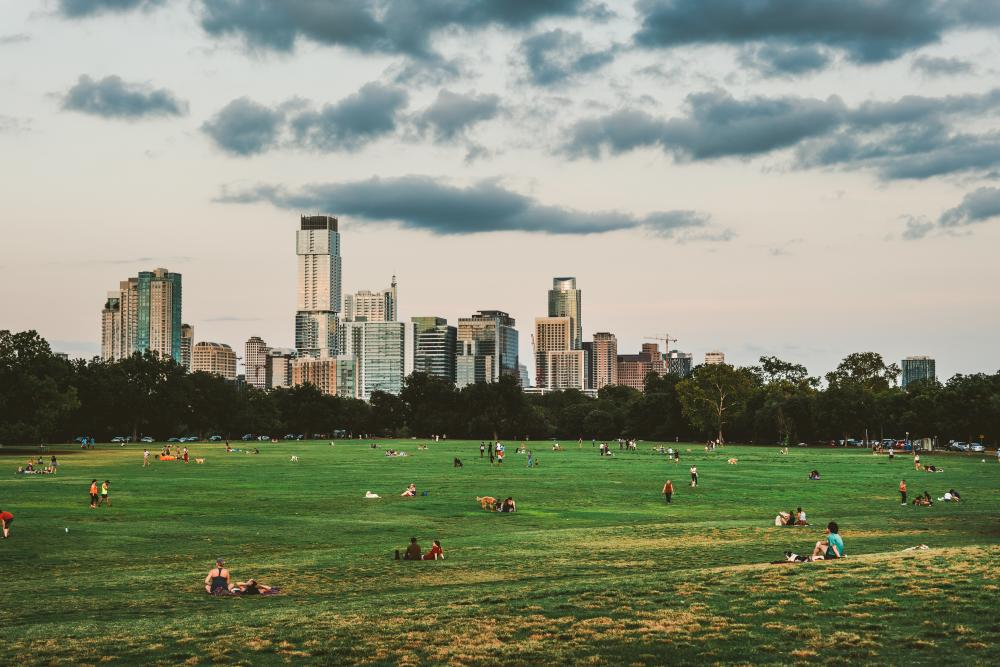
Name and Location: Zilker Park is a 351-acre park located at 2100 Barton Springs Rd in Austin, Texas.
History and Significance: Zilker Park was established in 1917 and named after founder Andrew Zilker who donated the land to the city. It is a beloved Austin staple, known for sweeping hill country views, hike and bike trails, picnic facilities, Zilker Botanical Garden, Barton Springs Pool, and hosting major events like ACL Fest.
What to Expect: Visitors enjoy recreational activities like hiking, jogging, biking, disc golf, canoeing and stand up paddle boarding in Town Lake. The park also features cultural and historical attractions, playgrounds, open lawns for games, concerts and events at the Austin City Limits Moody Theater and more.
Visitor Information: Zilker Park is open daily from 5 AM to 10 PM. Entry is free with parking fees applicable in some lots. Public transportation, bike share and scooters provide park access. Restrooms, concessions and rentals are available seasonally.
As Austin’s most beloved green space, 351-acre Zilker Park hosts over 5 million visitors a year for attractions like the Zilker Botanical Garden, Zilker Hillside Theater, Barton Springs Pool, kayaking on Lady Bird Lake, a miniature train, playscapes and soccer fields, and wide open space for kites, picnics, yard games and relaxing in the heart of the city. The huge park also connects to miles of hiking along the Barton Creek Greenbelt and Town Lake trails.
Lady Bird Johnson Wildflower Center

Name and Location: The Lady Bird Johnson Wildflower Center is a botanic garden dedicated to Texas native plants located at 4801 La Crosse Avenue in southwest Austin.
History and Significance: Founded in 1982 and renamed for former first lady Lady Bird Johnson in 1995, its mission is to increase sustainable landscapes using native plants through education, research and conservation. The center features over 900 native Texas species and 7 distinct gardens across 16 acres.
What to Expect: Visitors can explore outdoor gardens, exhibits and trails showcasing vibrant native flowers, grasses, shrubs and trees. The center offers family activities, informational signage for self-guided tours, as well as events, classes and access to botanical resources promoting environmental stewardship.
Visitor Information: The center is open Tuesday-Sunday 9 AM – 5 PM year-round, except major holidays. Admission is $10 for adults with options for guided tours and rental facilities. Free parking is available on-site.
Founded by the former First Lady, this public botanical center near Circle C Ranch features over 900 native Texas plant species outdoors on 16 acres of gardens and across 60 acres of surrounding wildflower meadows open for visitors to identify wildflowers and enjoy Hill Country nature at its finest. Themed sections like Luci’s Garden, the Demaree Garden and Family Garden provide trailside beauty and seating nooks. Beyond appreciating gorgeous blooms, the center’s mission focuses on statewide plants conservation through research and education.
Emma Long Metropolitan Park
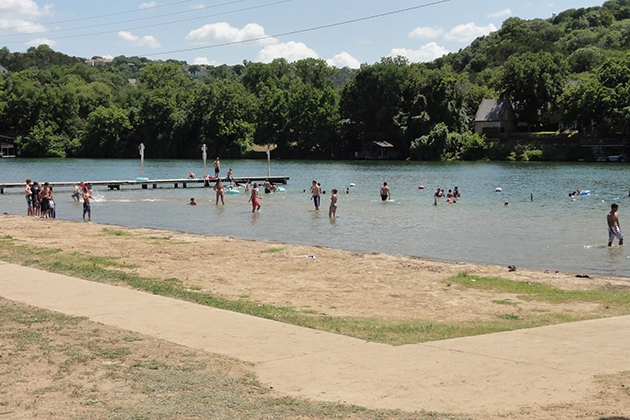
Name and Location: Emma Long Metropolitan Park is situated on City Park Road bordering Lake Austin roughly 15 minutes northwest of downtown Austin.
History and Significance: Originally a private stretch along Lake Austin, Emma Long Park has offered public green space for camping, boating and relaxation since 1979. Its namesake Emma Long was an Austin philanthropist dedicated to community causes like park conservation.
What to Expect: Visitors enjoy waterfront views perfect for swimming, paddle boarding and boating. Other amenities include reservable group picnic areas, over 10 miles of hiking and biking trails, volleyball courts, playgrounds and access to worms, crickets and minnows at the Sandy Creek bait stand.
Visitor Information: The park is open daily from dawn until dusk unless camping overnight. Entry requires nominal day use or camping fees. Restrooms and athletic equipment rentals are available seasonally.
Offering over 1,100 acres of recreational space immersed in Texas Hill Country scenery, Emma Long Metropolitan Park spans both sides of Lake Austin with 12 miles of mountain bike trails, campsites both primitive and upgraded, sand volleyball courts, horseshoe pitches, hot showers facilities and some of the city’s most coveted swimming areas like Twin Falls rock formation. Nearby cityscape views make this a treasured natural respite to boat, swim, hike and simply relax lakeside just minutes from downtown.
Bull Creek District Park

Name and Location: Bull Creek District Park spans over 700 acres located in the heart of Austin at 6701 Lakewood Drive near Lake Austin.
History and Significance: Created in 1951, Bull Creek offers diverse recreational opportunities along the Colorado River including overnight camping, picnicking, and over 8 miles of hiking trails that highlight Austin’s unique ecology of limestone, springs and woodlands.
What to Expect: Visitors traverse scenic trails and footbridges crossing the creek, admire wildlife and native plants, launch canoes or kayaks into Lake Austin, reserve picnic sites with grills, relax under the shade of oak trees, and enjoy access to tennis and volleyball courts.
Visitor Information: The park is open daily from 5 AM to 10 PM unless camping overnight. Entry fees of $2-10 apply depending on activities. Leashed pets are welcome in most areas and restrooms are available.
At almost 800 acres, Bull Creek winds for over 5 miles through the park’s rugged Hill Country terrain south of Highway 360. Visitors enjoy ample space for taking dogs on trails that cross the creek several times, mountain biking loops, tennis and picnic spots with grills for a day immersed in nature without leaving Austin city limits. Especially in springtime, vibrant wildflowers color the creek banks to make Bull Creek Greenbelt a local favorite worth discovering.
McKinney Falls State Park

Name and Location: McKinney Falls State Park spans over 750 acres at 5808 McKinney Falls Parkway, 12 miles southeast of downtown Austin.
History and Significance: Occupied for over 12,000 years, the park is named after Thomas McKinney who settled the land along Onion Creek in the mid-1800s. Its historic homes, waterfall springs and diverse habitat make it a unique Travis County retreat.
What to Expect: Outdoor recreation includes camping, hiking, mountain biking, rock climbing, horseback riding, swimming in the Upper Falls pool and exploring ruins of Smith Rock Shelter, the Parks Homestead and more. Wildlife like roadrunners and deer are plentiful.
Visitor Information: The park is open daily from 8 AM to 10 PM with overnight camping access. Entry fees of $6-8 apply. Leashed pets allowed in designated areas. Restrooms, athletic equipment rentals and food services available seasonally.
Protecting over 750 acres in Southeast Austin, McKinney Falls State Park holds many distinctions as one of Texas’ oldest parks, with the upper falls cascade considered the highest point in Travis County. Hiking trails cover over 10 miles through oak and cedar woodlands with views of unique rock formations and the park’s two scenic waterfalls fed by spring-fed Onion Creek. Campsites and playgrounds welcome visitors seeking space and nature without traveling far from downtown.
Auditorium Shores Park

Name and Location: Auditorium Shores is an urban park spanning 88 acres along the south shore of Lady Bird Lake downtown at 920 Riverside Drive.
History and Significance: Formerly the location of major Austin events like SXSW, Auditorium Shores provides expansive waterfront access and views of the Austin skyline. Its name recognizes the former city auditorium that stood for decades as a cultural hub.
What to Expect: Visitors enjoy picnicking on the sprawling lawn with high-rise views. Recreation includes walking, jogging or biking the Butler Hike and Bike Trail encircling Lady Bird Lake. Off-leash dog areas, park facilities rentals, and seasonal food vendors provide convenience.
Visitor Information: The park is open daily 5 AM to 10 PM unless events warrant extended hours. Entry is free. Parking access from Riverside Drive and Brazos Street. Restrooms, water fountains and athletic equipment rentals on-site seasonally.
Set directly across Lady Bird Lake from downtown on South Congress, this lush green space serves as prime parade and festival grounds while also offering picnic spots, hike and bike trails, kayak rentals and unmatched skyline views. Visitors find space to play catch, fly kites, take Instagram-worthy photos of the Austin cityscape and walk leashed dogs. Many claim the Austonian and other towers resemble apt building blocks visible in the distance.
Violet Crown Trail
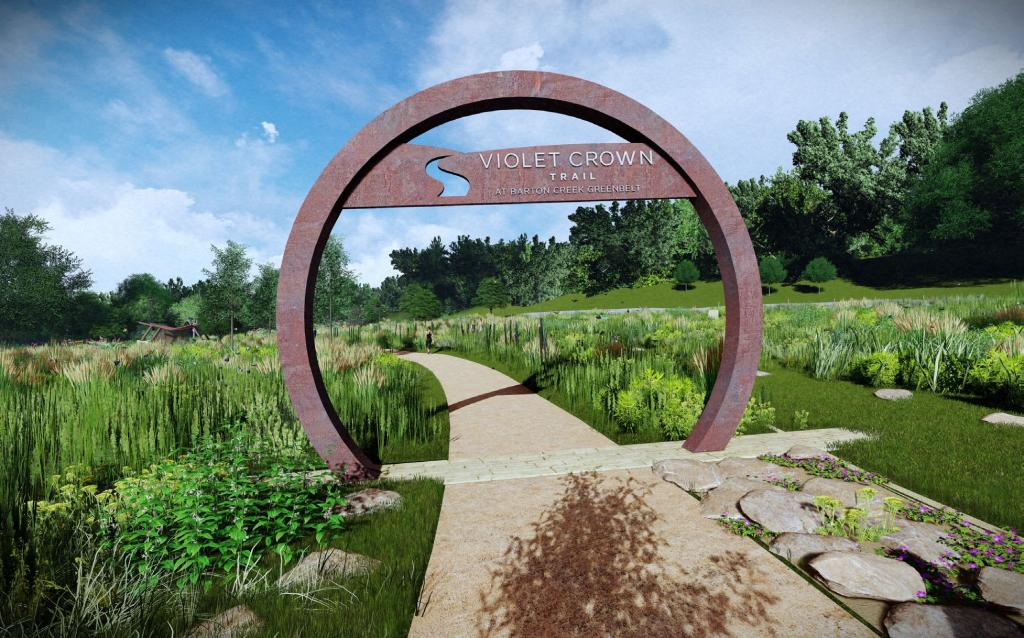
Name and Location: The Violet Crown Trail is envisioned as a 30-mile loop encircling Austin following restored creekways. Completed sections currently span Zilker Park to Techni Center Drive.
History and Significance: First proposed in 2014, the Violet Crown Trail honors Austin’s iconic violet crown sunsets. Its mission is to connect neighborhoods via protected hiking and biking trails while improving watershed land stewardship and education. Over 15 miles are already complete.
What to Expect: Trail sections feature 10-14 foot wide paths with interpretive signage on native flora and fauna, seating, trailheads and access to shops and restaurants. Cyclists, walkers, runners and leashed dogs can traverse creek vistas at their own pace while enjoying nature amid urban areas.
Visitor Information: Completed trail segments are open daily until 10 PM. Access the Zilker Park trailhead at Stratford Drive and Lou Neff Road or Spyglass trailhead at3453 S. Lamar Blvd. Future plans aim to complete the loop by 2025 through partnerships.
Still expanding toward a 30-mile multi-use loop around Austin, this trail system ultimately aims to connect Zilker Park and Barton Springs downtown all to the Hill Country’s open spaces west near Lakeway. Currently about 11 miles of scenic pathways welcome walkers, runners and bikers to explore parks and neighborhoods between South Austin and Sunset Valley with more growth planned. Vibrant wildflowers color sections winding through undeveloped ranch lands and tranquil city nature preserves.
Roy G. Guerrero Park

Name and Location: Roy G. Guerrero Park, spanning over 350 acres, is located in southeast Austin at 400 Grove Blvd along the Colorado River.
History and Significance: Dedicated in honor of Sergeant Roy G. Guerrero, the park has provided access to the Colorado River for recreation since opening in 1953. Its off-leash dog park, swimming pool, kayak access and proximity to downtown make it a popular community hub.
What to Expect: Visitors enjoy picnicking, fitness trails, sand volleyball courts, athletic fields, playgrounds with water features, batting cages and access to canoeing and fishing along the river. The adjacent pool features slides, lap lanes and concessions.
Visitor Information: The park grounds are open daily 5 AM to 10 PM with seasonal hours for rentals, trails and the pool. Entry is free besides nominal pool admission fees. Parking available within the park grounds.
Extending shoreline access along southern side of downtown’s famous bat-viewing area at Congress Bridge, this lush 85-acre park built on a former industrial site now provides swimming access plus trails and boardwalks for running and bicycling along the Colorado River. Amenities include boat launches, playscapes, picnic tables, fishing piers, public art installations, native wetland plant gardens and prime spots for admiring Austin’s famous colony of 1.5 million bats spiraling over the river at dusk during summer months, making it both a natural escape and downtown attraction.
Pease District Park

Name and Location: Pease District Park encompasses 25 acres in East Austin bordering Lake Austin at 1100 Kingsbury Street.
History and Significance: Pease Park, named after Governor E.M. Pease, has offered tranquil lakefront access to Austin residents since being converted from farmland in 1930. Its scenic limestone cliffs, wooded trails and historic Kingsbury Pavilion make it an oasis amid urbanization.
What to Expect: Outdoor options include boating, fishing, biking, jogging, light climbing and wildlife viewing. Structured playscapes, picnic areas, athletic fields, the renovated Kingsbury Pavilion event site and scenic skyline views provide leisure and entertainment.
Visitor Information: The park is open daily 5 AM to 10 PM or midnight for special events. Entry is free. Limited parking access from Kingsbury or Riverside Drive. Leashed pets allowed.
In East Austin, this major park contains the historic Kingsbury House and a section of Waller Creek plus baseball diamonds, soccer pitches, playgrounds, picnic spaces and walking trails passing a pretty pond with fountain. Visitors also access the Violet Crown Trail and wooded Northeast Greenway route. With rambling open green space punctuated by majestic mature pecan and oak trees, Pease Park makes a relaxing, dog-friendly outing when seeking neighborhood character beyond Austin’s tourist centers.
Commons Ford Prairie Park
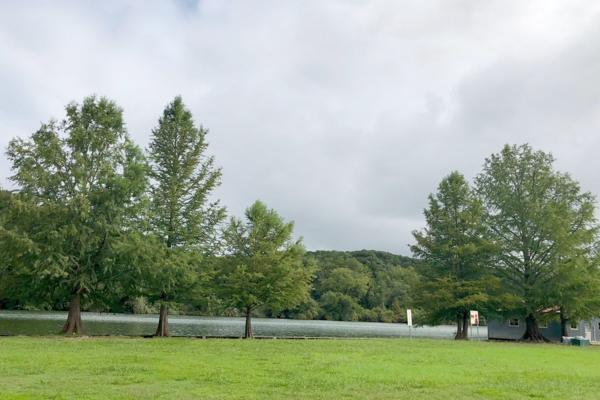
Name and Location: Commons Ford Prairie Park & Nature Preserve consists of 104 acres at 614 N. Commons Ford Road bordering the Colorado River in West Austin.
History and Significance: Home to rare bird species and native wetland grasses, the ecologically significant Commons Ford Prairie was jointly purchased by Travis County and Austin in 2001 to manage access and land use while opening the space for conservation-focused public recreation.
What to Expect: Visitors traverse mowed paths or create their own trail through native prairie grasses while admiring birds, wildflowers and secluded Colorado River views. Interpretive signage highlights ecological insights. The land is intentionally left largely untouched to protect habitats.
Visitor Information: The park and nature preserve are open daily from dawn until dusk. Access requires nominal daily entry fee paid on-site or via annual pass. No restroom or drinking water available. Leashed pets allowed.
Protecting almost 700 acres within a wildlife management area near Travis County’s far western border, Commons Ford Ranch Metropolitan Park preserves native prairie, savanna and wetland ecosystems where foxes, white-tailed deer, javelina hogs plus 200 bird species inhabit the landscape crossed by scenic Pedernales River. Over 8 miles of multi-use trails also cater to mountain bikers, trail runners and equestrians navigating through the ecosystems sustained by prescribed seasonal burns.
Walter E. Long Park
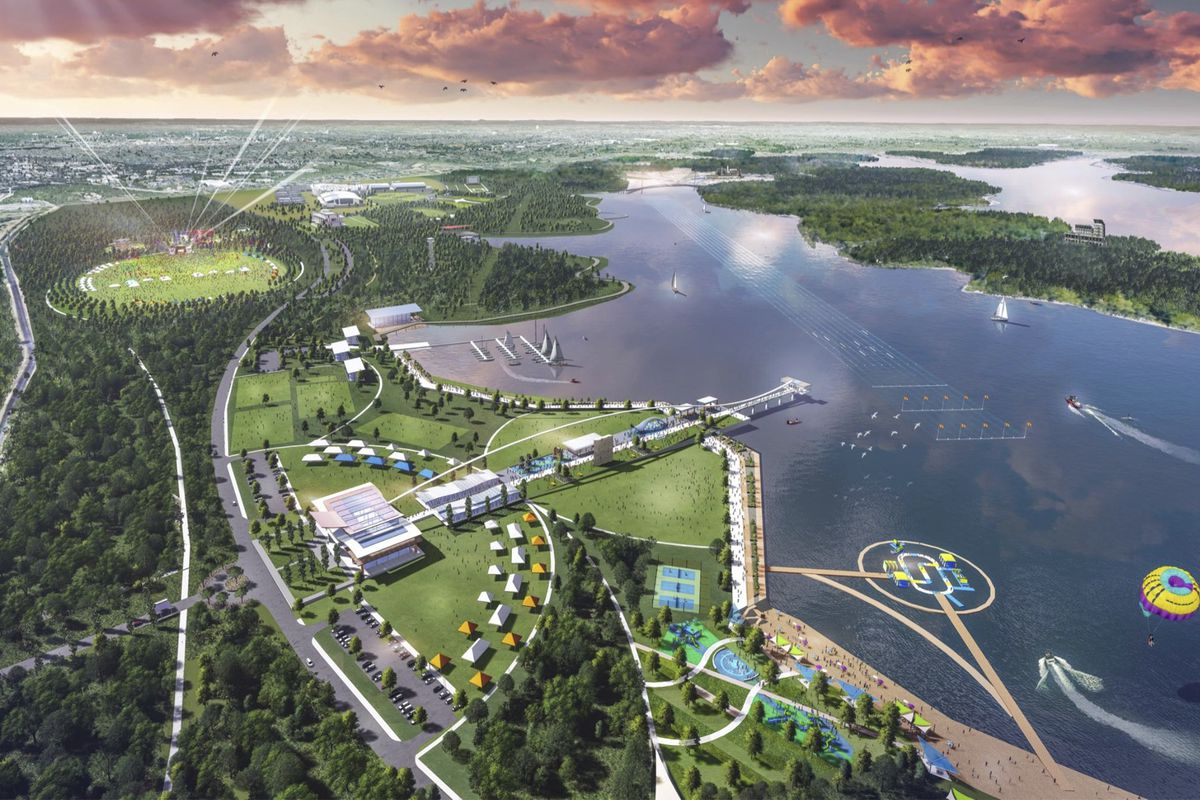
Name and Location: Walter E. Long Park Reserve stretches across 893 acres at 1601 ESC Rear Range Rd. where Decker Creek meets the Colorado River east of Austin.
History and Significance: Settled as farmland along the Colorado River floodplain in the mid-1800s, throughout the 20th century the land served purposes from a WWII internment camp to gravel mining before Travis County established it as a natural park space protecting unique habitats in 2001.
What to Expect: Outdoor recreation includes boating, fishing, wildlife viewing, over 10 miles of multi-use trails and access to the Texas Mountain Biking Trails built by Austin Ridge Riders bicycle group. Reservations accommodate group functions.
Visitor Information: The park is open 8 AM until dusk daily with extended overnight access. Entry requires nominal daily fees. Equestrian parking offers trailer access. On-site restrooms, picnic sites, and drinking water available.
Offering over 900 acres of recreational space in far East Austin, Walter E Long Park contains the Decker Creek Power Plant ruins, almost 10 miles of hiking and biking trails through forests and meadows with lake views, sports fields and access to boating, fishing and swimming in Lake Walter E. Long. Especially vibrant each spring when Texas wildflowers bloom, the park welcomes trail enthusiasts, picnickers and nature lovers seeking a rustic escape close to urban life.
Conclusion
Whether seeking lush gardens, access to water fun or sprawling land preserved in a natural state, Austin parks have space allowing visitors to tailor outdoor experiences to match interests while soaking up gorgeous Hill Country environs and creative local character – from Zilker’s city heart to Commons Ford’s prairie expanse. Ramble along wooded waterways downtown or traverse regional trails leading to secluded neighborhood gems. With options spanning over 20,000 acres of total public green space blanketing the capital inside and out, nature stays close for active Austin explorations.

